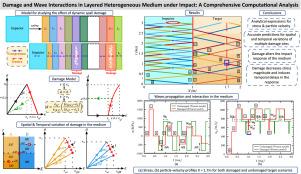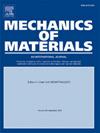Comprehensive analysis of wave interactions and resulting spall damage in layered heterogeneous medium under impact
IF 3.4
3区 材料科学
Q2 MATERIALS SCIENCE, MULTIDISCIPLINARY
引用次数: 0
Abstract
The effect of dynamic spall damage on the response of layered medium subjected to one-dimensional impact involving an impactor and a multi-layered target is investigated. The study examines the damage caused by elastic waves below the Hugoniot Elastic Limit (HEL) during impact events. Analytical expressions of stress and particle velocity derived from mass and momentum conservation principles are utilized to solve the wave interactions within the impactor-target system, considering reflections, transmissions, and wave interactions between layers. These analytical expressions, integrated into a computational framework, facilitate the monitoring of material responses following each wave interaction, thereby analysing the impact response of the layered medium. Wave interactions, resulting in tensile stresses, that can cause damage to the target have been identified. A strain-based damage initiation and evolution law is incorporated into the developed computer program to predict damage in each layer of a medium. Damage alters the medium’s impact behaviour by decreasing stress magnitude and inducing temporal delays in the response due to attenuated wave propagation speed. The occurrences of tensile stress are explored, analysing spatial and temporal variations of multiple damage incidents within the layered medium. The tension at the interface between two layers can induce damage in one or both adjacent layers, leading to debonding between layers. The effect of damage on the impact response of the medium is analysed by comparing the results for the damaged and undamaged target scenarios. The impact behaviour of a single-layer and a multi-layer target obtained from the present model, in terms of stress and particle velocity, is verified through Finite Element simulations of the identical impact problems, where the damage evolution criterion is incorporated using a VUMAT subroutine. The outcomes derived from this study align closely with Finite Element (FE) results.

冲击下层状异质介质中波的相互作用及其导致的剥落损伤的综合分析
本研究探讨了动态剥落损伤对层状介质在受到涉及撞击器和多层目标的一维撞击时的响应的影响。研究探讨了在冲击事件中低于休格诺弹性极限(HEL)的弹性波造成的破坏。根据质量和动量守恒原理推导出的应力和质点速度的分析表达式被用来解决撞击器-目标系统内的波相互作用,同时考虑到反射、透射和层间的波相互作用。这些分析表达式与计算框架相结合,有助于监测每次波相互作用后的材料响应,从而分析分层介质的冲击响应。已确定波的相互作用会产生拉伸应力,对目标造成破坏。在开发的计算机程序中纳入了基于应变的损伤起始和演变规律,以预测介质各层的损伤情况。由于波的传播速度减弱,损伤会降低应力大小并导致响应的时间延迟,从而改变介质的冲击行为。通过分析多层介质中多个损伤事件的空间和时间变化,对拉伸应力的发生进行了探索。两层介质界面处的拉力可导致相邻的一层或两层发生损坏,从而导致层间脱粘。通过比较受损和未受损目标情况下的结果,分析了损伤对介质冲击响应的影响。通过对相同撞击问题的有限元模拟,验证了本模型获得的单层和多层目标在应力和颗粒速度方面的撞击行为。本研究得出的结果与有限元(FE)结果非常吻合。
本文章由计算机程序翻译,如有差异,请以英文原文为准。
求助全文
约1分钟内获得全文
求助全文
来源期刊

Mechanics of Materials
工程技术-材料科学:综合
CiteScore
7.60
自引率
5.10%
发文量
243
审稿时长
46 days
期刊介绍:
Mechanics of Materials is a forum for original scientific research on the flow, fracture, and general constitutive behavior of geophysical, geotechnical and technological materials, with balanced coverage of advanced technological and natural materials, with balanced coverage of theoretical, experimental, and field investigations. Of special concern are macroscopic predictions based on microscopic models, identification of microscopic structures from limited overall macroscopic data, experimental and field results that lead to fundamental understanding of the behavior of materials, and coordinated experimental and analytical investigations that culminate in theories with predictive quality.
 求助内容:
求助内容: 应助结果提醒方式:
应助结果提醒方式:


